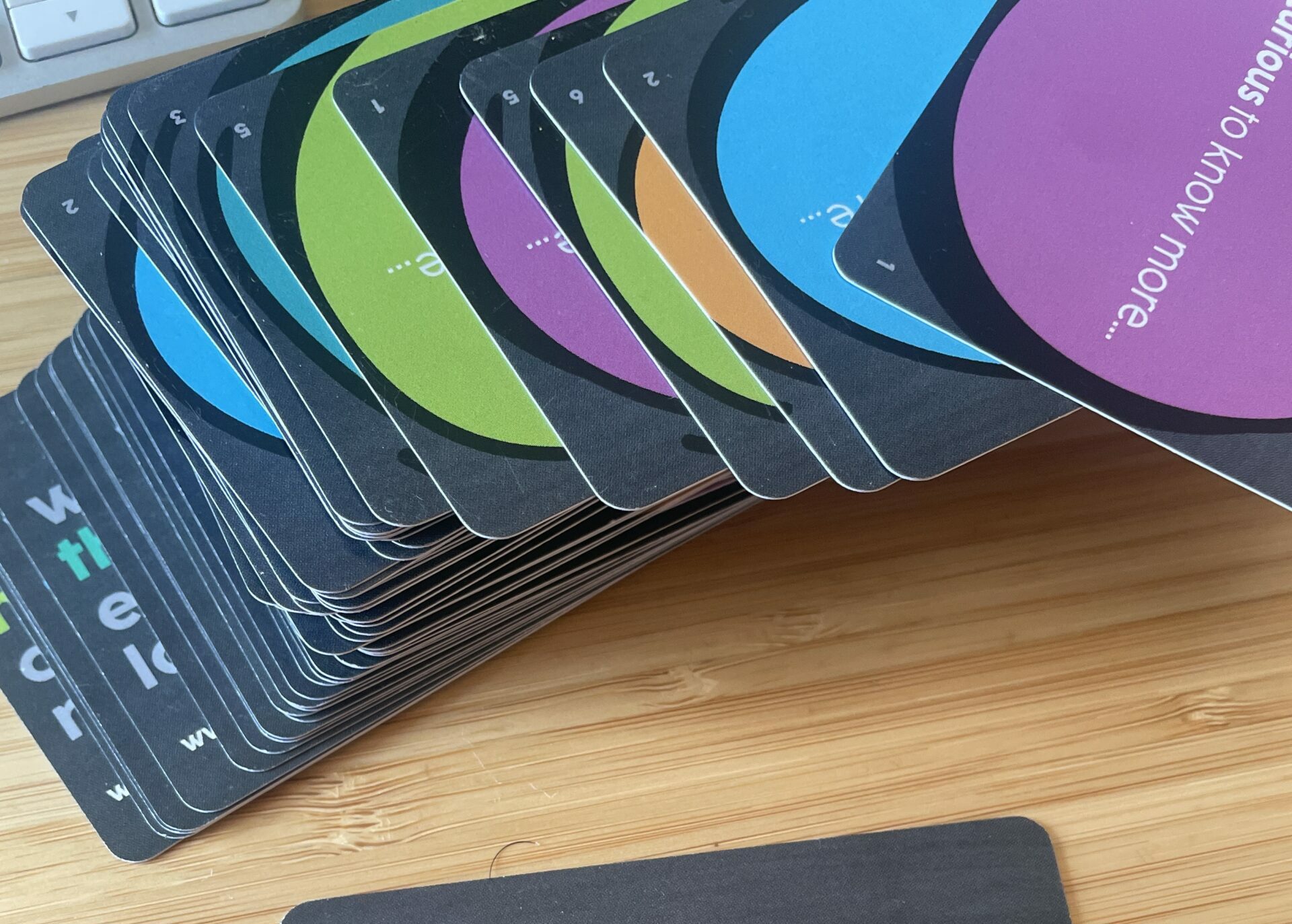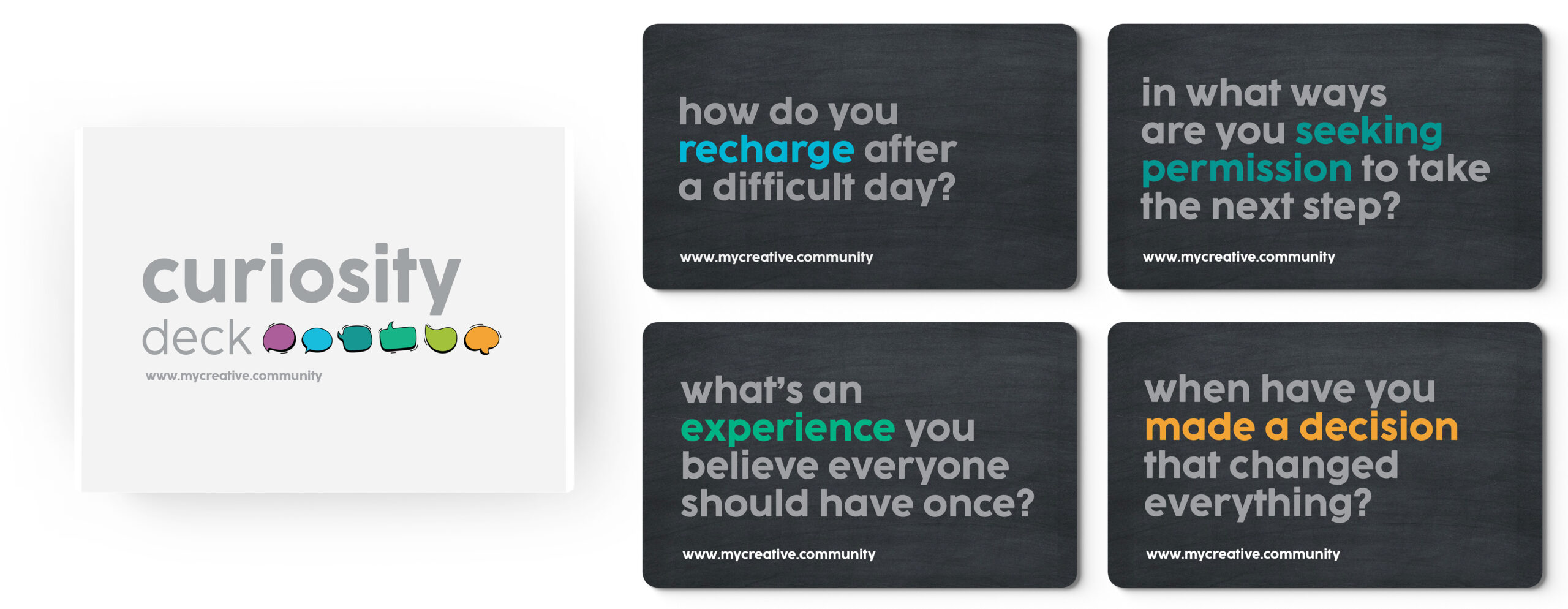One of our favorite ways to transform everyday conversations into deeper and more meaningful interactions is through the use of our Curiosity Card Deck. Whether you’re a facilitator, educator, or simply someone looking to deepen your relationships, these cards are crafted to spark engagement and understanding.
Here are six unique ways to use the Curiosity Card Deck in various settings to foster genuine connections. If you’ve found creative ways to put the cards to use, let us know in the comments!
Activity #1: Question Swap (30 mins)
Framing (5 minutes):
- Begin by asking the group what are some typical questions they ask someone when first meeting. Often times the list is quite small and predictable. Next, introduce the concept of the Curiosity Cards as a tool to deepen the quality of the conversations you have by asking more meaningful questions.
Logistics (15 minutes):
- Place the Curiosity Cards in the center of the room. Each participant picks a card and pairs up with another person. They ask their question to their partner and then exchange cards after both have answered.
- Next, they raise their cards above their heads to signal they are looking for a new partner and repeat the process.
- You can add a twist to a round by encouraging your participants to add a simple phrase to end of each question, such as “…at our company” or “…in our community.” This will change the nature of the conversation and is a good way to highlight the power of a well-framed question.
Debrief (10 minutes):
- Ask what struck participants about their conversations and how the depth of understanding improved with structured questioning and active listening. Discuss whether they noticed a difference between the rounds and how they might apply this activity to conversations they have outside of this experience.
Activity #2: Values Exploration (45 mins)
Framing (5 minutes):
- Use this activity to explore and align on team or group values. Explain how Curiosity Cards can facilitate deeper understanding of individual and shared values.
Logistics (30 minutes):
- Gather participants into small groups of 3 and each person selects 3 random question cards. One-by-one, each person shares their answer to the 3 questions.
- Meanwhile, the other two members in their group write down what values they heard referenced.
- After their partner has finished answering their questions, they share what values they heard and the group notes any overlapping values.
- Repeat this process for each team member insights. After all 3 members have gone, the group discusses how their individual values align with their collective values.
Debrief (10 minutes):
- Wrap up by summarizing the shared values that emerged and discuss steps to integrate these values into everyday practices or team goals.
Activity #3: Role-Reversal Brainstorming (30 mins)
Framing (5 minutes):
- This activity uses the cards to encourage creative thinking and problem-solving from different perspectives.
Logistics (20 minutes):
- Participants draw cards and are assigned a role or perspective from which they must answer (e.g., a customer, a senior executive, a competitor).
- They discuss their responses with the group, focusing on how different perspectives can lead to new insights. This can be done 1-on-1 or in small groups.
Debrief (5 minutes):
- Discuss how changing perspectives can alter problem-solving approaches and lead to innovative solutions.
Activity #4: Category Deep Dive (45 mins)
Framing (5 minutes):
- Introduce the 6 different categories available in the Curiosity Card Deck.
- Allow the group to select a category that they feel is particularly relevant or necessary for their current situation, such as “Chart Your Path” for teams needing alignment on vision and goals or “Visualize a Prototype” for groups who are struggling to turn an idea into reality.
Logistics (30 minutes):
- Organize participants into small groups of 3. As the facilitator, select a card from the chosen category and announce it to everyone.
- Each group discusses that question together and reflects on how the question relates to their roles and current challenges or goals.
- You can repeat this process with as many cards from that category as you’d like.
Debrief (10 minutes): Groups come back together and share their insights with the wider team, promoting a collective understanding and alignment on the category’s themes. Discuss how the focused exploration of a single category helped clarify the team’s needs and how they can apply their insights going forward.
Activity #5: Ranking Relay (45 mins)
Framing (10 minutes):
- Explain that the group will be tasked with identifying what level of Explain that each category can contribute differently to the team’s development. The group will work through one category at a time to rank the questions based on their perceived importance or relevance.
Logistics (20 minutes):
- Divide the group into small teams of 3-6 people. Give each group 3 cards from each of the 6 categories, so they have a total of 18 cards.
- Together, each group must rank the cards they’ve been given from most to least important when considering what they need to know from one another to be most effective as a team.
- After all groups have completed their ranking, have them flip their cards over to reveal the color of the category that each card is connected to. Each group should make note of the top 2 categories in their list.
Debrief (15 minutes):
- Review if there were certain categories that were consistently ranked at the top for all of the groups. If so, what does that tell you about what’s important for this team to focus on moving forward.
- Discuss how this activity might influence future focus areas or impact on the team’s dynamics and objectives.
Activity #6: Where’s Your Challenge (60 mins)
Framing (5 minutes):
- Introduce the idea that each card reveals different aspects of our personal development and overall team dynamics. We are all on a journey of growth. This activity helps participants recognize the growth and milestones they’ve personally achieved, and stretch towards the next challenge they want to overcome.
Logistics (25 minutes):
- Lay all of the cards out on a table. Have each participant select one card that feels relatively easy for them to answer because of a past experience they’ve had, and one card that they find personally relevant and challenging to something they are currently exploring.
- Once everyone has selected two cards, have participants pair up. With their partner, discuss why they selected each card and what that tells them about where they are at on their journey.
Debrief (15 minutes):
- Bring groups back together and invite folks to share what struck them about their conversation.



